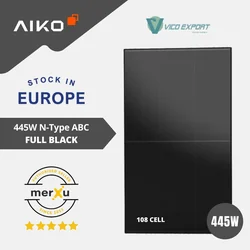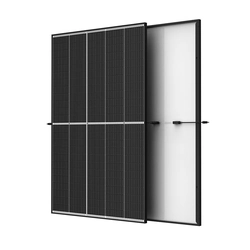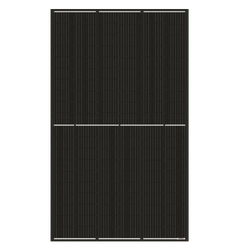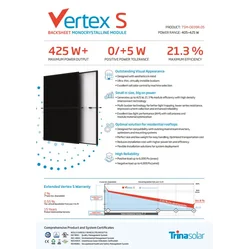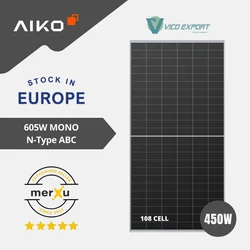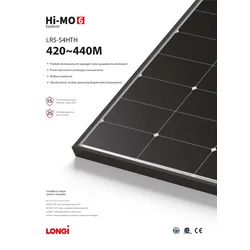
PV Module Manufacturing Technology
Trends, Efficiency, Future (Silicon vs Perovskite)
Dominance of PV Modules in Silicon Technology
Photovoltaic (PV) modules produced using silicon technology currently constitute the most popular group of modules in the solar energy field. Their prevalence is attributed to several factors, with the most significant being competitive pricing, ease of application, and impressive resilience. Silicon technology enables the mass production of PV modules, resulting in their widespread availability in the market. Additionally, silicon is a readily available material, further reducing production costs. These modules are known for their high energy efficiency and durability, making them extremely attractive to consumers and industries alike. As a result, silicon technology has become a cornerstone of the energy transition, facilitating the mass production of economically accessible and efficient solar energy.
The first silicon-based modules have been known for years. In practice, the initial solar cells were employed by NASA (National Aeronautics and Space Administration). Vanguard 1, the world's first solar-powered satellite, launched on St. Patrick's Day (March 17) in 1958, was designed to test the capabilities of a three-stage launch vehicle and assess the impact of the space environment on the satellite and its systems in Earth's orbit. Vanguard 1 was the second American satellite in orbit after Explorer 1 and remains the oldest artificial object still orbiting the Earth to this day.
New Generation of Photovoltaic Modules: Innovations in Silicon Technology
1. Difference Between N-Type and P-Type Cells: Choosing in Photovoltaics
Despite the earlier introduction of N-Type cells, P-Type cells dominate the market, accounting for up to 90% of available solutions. N-Type cells are distinguished by higher efficiency, durability, and lower degradation due to light; however, they are currently more expensive than P-Type cells. Forecasts indicate a potential increase in the popularity of N-Type cells in the future as their prices decrease, possibly leading to a complete technology shift in the photovoltaic industry. More information on N-Type and P-Type cells can be found HERE.
2. Are Photovoltaic Panels Glass? Glass-Glass Technology
Glass-Glass photovoltaic module technology stands out with an innovative construction approach. It involves replacing the traditional layer of EVA material on the lower part of the module with a second layer of glass, providing benefits in terms of durability and efficiency. The module's construction is based on five layers, including a thick glass pane, resulting in an extended warranty of up to 30 years. Additionally, Glass-Glass modules enable the use of bifacial technology, absorbing radiation from both the front and rear, enhancing the efficiency of the photovoltaic installation. More information on Glass-Glass technology can be found HERE.
3. What are Shingled Modules?
Shingled technology is a revolution in photovoltaics, allowing for higher power density at competitive costs compared to traditional PV modules. In this technology, cells are arranged like shingles, minimizing resistive losses and increasing the working surface area of the panels. Advantages of Shingled technology include lower ohmic losses, lower module operating temperature, resistance to PID and LID effects, absence of hotspots, and efficient use of space, translating into stable module operation and space and cost savings. Shingled technology represents an innovative solution, combining efficiency, durability, and savings for investors. More information on Shingled modules can be found HERE.
These are just a few of the existing technologies generating interest in the market. If you are interested in more, the entire spectrum of offerings can be seen on merXu.com.
Oferte de top


TRINA 440W Panou solar Trina Vertex S+ Modul PV TSM-440-NEG9R.28 N-Type Black Frame 440W 440 W

Jinko JKM480N-60HL4-V, Jinko 480 cadru negru

Trina 420W TSM-420DE09R.05 Full Black

Modul fotovoltaic Panou fotovoltaic 435Wp Longi Solar LR5-54HTH-435M Hi-MO 6 Explorer Black Frame Cadru negru

Modul fotovoltaic Jinko 480 480W JKM480N-60HL4-V BF

Modul fotovoltaic Panou fotovoltaic 440Wp Longi Solar LR5-54HTH-440M Hi-MO 6 Explorer Black Frame Cadru negru
Perovskites: Is a Revolution in Photovoltaics on the Horizon?
What are Perovskites?
This organic material occurs naturally in minerals and lava. Its structure is similar to silicon. The term "perovskite" refers to both the mineral and the crystalline structure. The perovskite structure is a general form of ABX3, where A is an organic cation, B is an inorganic cation, and X is a halogen anion. Perovskites have diverse properties, including superconductivity, magnetoresistance, and spin-dependent transport.
Application of Perovskites in Photovoltaics
Perovskites have become a key material in solar cells since 2012. Their structure, often based on metal halides from Group IV, allows for the creation of cheap, efficient photovoltaic panels. Particularly, lead-based perovskites are gaining recognition for their strong absorption in the visible regime, long carrier diffusion length, and easy production. Perovskites in Solar Cells constitute the third generation of photovoltaic cells, alongside DSSC, OPV, and Quantum PV.
Perovskites offer a broad absorption spectrum, resulting in higher solar energy conversion efficiency. Currently, the potential to achieve efficiency in PV cells based on this technology is estimated at 33%, significantly better than pure silicon cells.
Advantages of Perovskite Solar Cells
Perovskites have significant potential for several reasons:
Wide absorption spectrum increases energy conversion efficiency.
High efficiency, reaching up to 33% in the laboratory.
Simple production, especially as thin-film modules.
No need for rare elements.
PSC-based modules can be shaped like traditional rectangular solar panels or be flexible, opening up new applications and markets.
Production of perovskite solar modules has a minimal environmental impact, depending on the production method used.
Challenges and Perspectives
Despite promising features, perovskites face challenges such as instability and concerns related to lead usage. Research on improving stability and seeking alternatives to lead is crucial. The presence of lead in commercially used products poses a problem, and efforts are currently underway to replace lead with other elements such as tin. Despite these challenges, perovskites have the potential to revolutionize the photovoltaic industry due to easy production, low costs, and versatile applications.
Future of Perovskites in Photovoltaics
Innovations and Research
Future research on perovskites will focus on increasing stability, improving efficiency, and experimenting with new two-dimensional structures. Introducing perovskites into tandem c-Si/perovskite cells is a promising step forward. Currently, many scientific and commercial institutions are working on implementing this technology.
Some notable research laboratories include:
Ecole polytechnique fédérale de Lausanne (EPFL) - Switzerland
Lawrence Berkeley National Laboratory (Berkeley Lab) - USA
Solliance - Partnership of the Netherlands, Belgium, and Germany
Kyoto University - Japan
Saule Technology - Poland
Applications
Perovskites have the potential not only in photovoltaics but also in electroluminescent diodes and resistive memories. Their versatility makes them a material worth monitoring for future innovations in materials science and renewable energy. Imagine new applications of perovskites as flexible coatings printed on film or a solar layer on small devices like phones, watches, or laptops, actively converting solar energy into electricity. Vehicles and building windows/facades could also be potential carriers of perovskite layers. The possibilities are nearly limitless. Perovskite cells have the potential to revolutionize the perception of photovoltaics, overcoming several challenges mentioned earlier.
Adaptation Perovskites to PV
Polish Highlight: Olga Malinkiewicz and Saule Technology
Saule Technologies: Revolution in Photovoltaics
Years of work by Olga Malinkiewicz and the development of Saule Technologies have positioned Poland at the forefront of perovskite-based photovoltaics. During her physics studies, Olga moved to Spain, where she developed an innovative and economical method for producing printed perovskite solar cells. These complex chemical compounds surpass traditional silicon cells in terms of production costs and efficiency. Their incredible flexibility and partial transparency make them an ideal solution for modern technologies.
Olga Malinkiewicz Recognized by the Scientific Community
Awards and recognitions for Olga Malinkiewicz are nothing new. In 2014, the European Commission awarded her the main prize in the Photonics21 scientific competition for her contribution to perovskite development. Olga was also honored as an Innovator of the Year by "MIT Technology Review," and her startup, Saule Technologies, was named the startup of the year in Poland. Since then, her projects have gained recognition and interest worldwide.
Innovative Production in Poland
In 2016, Olga Malinkiewicz was awarded the Knight's Cross of the Order of Polonia Restituta by President Andrzej Duda for her outstanding contribution to the development of Polish science. In the following years, she gained international acclaim, and her company attracted significant investments for technology development. Today, Saule Technologies takes another step by opening the first large-scale perovskite solar cell factory in Wrocław. Poland's role in the energy revolution is becoming increasingly noticeable on the global stage.
Conclusion
The promising technology of perovskites in the context of photovoltaics is a crucial part of the third generation of solar cells alongside DSSC, OPV, and Quantum PV. Perovskites offer a wide absorption spectrum, resulting in higher solar energy conversion efficiency, reaching up to 33% in the laboratory. Despite promising features, perovskites face challenges such as instability and concerns related to lead usage. However, research aimed at improving stability and experimenting with new structures is directing towards commercial applications.
Poland, through Olga Malinkiewicz and Saule Technologies, plays a significant role in this revolution by opening the first large-scale perovskite solar cell factory in Wrocław. The future of perovskites in photovoltaics seems promising due to innovations, research, and applications in various fields, potentially revolutionizing the energy industry.
Article written: 2.01.2024
Source:
https://www.revoltenergy.eu/pl/blog/technologie-wytwarzania-ogniw-fotowoltaicznych-shingled
https://elektronikab2b.pl/fotowoltaika/53969-technologie-krzemowe-ogniw-fotowoltaicznych-na-rynku
https://solaris.energy/moduly-fotowoltaiczne-mwt/
https://www.chemistryworld.com/features/the-power-of-perovskites/7659.article [15/05/2020]
https://www.nrel.gov/pv/perovskite-solar-cells.html [15/05/2020]
https://www.ossila.com/pages/perovskites-and-perovskite-solar-cells-an-introduction [15/05/2020]
https://bizblog.spidersweb.pl/saule-technologies-olga-malinkiewicz
https://www.perovskite-info.com/companies-list/related-companies
